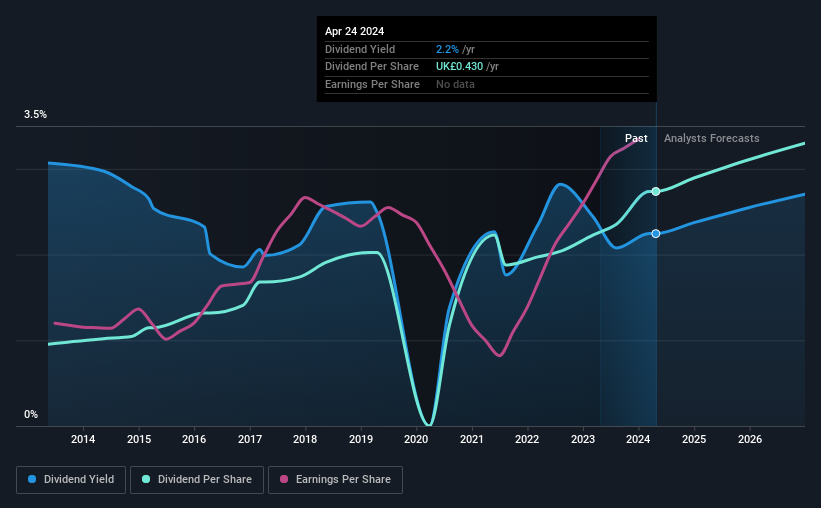- United Kingdom
- /
- Metals and Mining
- /
- LSE:HILS
Hill & Smith's (LON:HILS) Upcoming Dividend Will Be Larger Than Last Year's
Hill & Smith PLC's (LON:HILS) dividend will be increasing from last year's payment of the same period to £0.28 on 5th of July. Despite this raise, the dividend yield of 2.2% is only a modest boost to shareholder returns.
Check out our latest analysis for Hill & Smith
Hill & Smith's Dividend Is Well Covered By Earnings
If it is predictable over a long period, even low dividend yields can be attractive. The last dividend was quite easily covered by Hill & Smith's earnings. This indicates that a lot of the earnings are being reinvested into the business, with the aim of fueling growth.
Looking forward, earnings per share is forecast to rise by 41.9% over the next year. Assuming the dividend continues along recent trends, we think the payout ratio could be 38% by next year, which is in a pretty sustainable range.

Dividend Volatility
While the company has been paying a dividend for a long time, it has cut the dividend at least once in the last 10 years. Since 2014, the annual payment back then was £0.15, compared to the most recent full-year payment of £0.43. This means that it has been growing its distributions at 11% per annum over that time. Dividends have grown rapidly over this time, but with cuts in the past we are not certain that this stock will be a reliable source of income in the future.
We Could See Hill & Smith's Dividend Growing
Given that the dividend has been cut in the past, we need to check if earnings are growing and if that might lead to stronger dividends in the future. We are encouraged to see that Hill & Smith has grown earnings per share at 7.4% per year over the past five years. Earnings are on the uptrend, and it is only paying a small portion of those earnings to shareholders.
Our Thoughts On Hill & Smith's Dividend
In summary, it's great to see that the company can raise the dividend and keep it in a sustainable range. The payout ratio looks good, but unfortunately the company's dividend track record isn't stellar. The dividend looks okay, but there have been some issues in the past, so we would be a little bit cautious.
Companies possessing a stable dividend policy will likely enjoy greater investor interest than those suffering from a more inconsistent approach. At the same time, there are other factors our readers should be conscious of before pouring capital into a stock. For example, we've picked out 1 warning sign for Hill & Smith that investors should know about before committing capital to this stock. If you are a dividend investor, you might also want to look at our curated list of high yield dividend stocks.
Valuation is complex, but we're here to simplify it.
Discover if Hill & Smith might be undervalued or overvalued with our detailed analysis, featuring fair value estimates, potential risks, dividends, insider trades, and its financial condition.
Access Free AnalysisHave feedback on this article? Concerned about the content? Get in touch with us directly. Alternatively, email editorial-team (at) simplywallst.com.
This article by Simply Wall St is general in nature. We provide commentary based on historical data and analyst forecasts only using an unbiased methodology and our articles are not intended to be financial advice. It does not constitute a recommendation to buy or sell any stock, and does not take account of your objectives, or your financial situation. We aim to bring you long-term focused analysis driven by fundamental data. Note that our analysis may not factor in the latest price-sensitive company announcements or qualitative material. Simply Wall St has no position in any stocks mentioned.
About LSE:HILS
Hill & Smith
Manufactures and supplies infrastructure products in the United Kingdom, rest of Europe, North America, the Middle East, rest of Asia, and internationally.
Flawless balance sheet average dividend payer.
Market Insights
Community Narratives


Recently Updated Narratives

TAV Havalimanlari Holding will fly high with 25.68% revenue growth


Fiducian: Compliance Clouds or Value Opportunity?


Q3 Outlook modestly optimistic
Popular Narratives


MicroVision will explode future revenue by 380.37% with a vision towards success


The company that turned a verb into a global necessity and basically runs the modern internet, digital ads, smartphones, maps, and AI.



